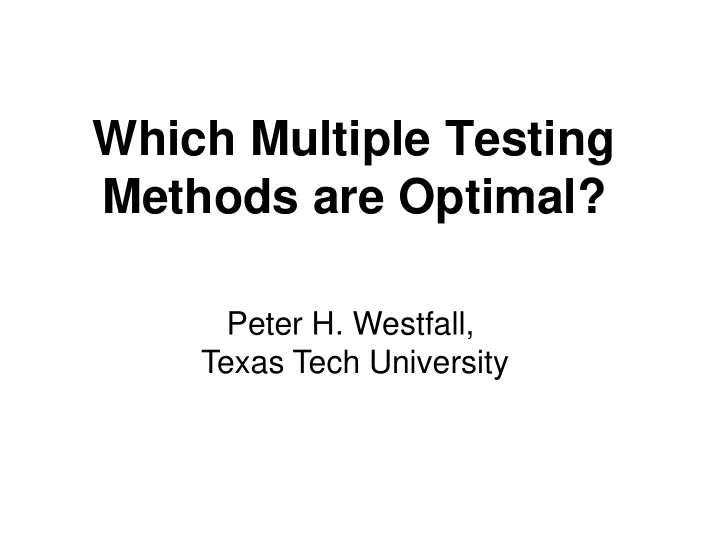

Which Multiple Testing Methods are Optimal? Peter H. Westfall, Texas Tech University
Background • The scientific literature has recently experienced an embarrassment of contradictory results: • Ioannidis, J.P. (2005), "Contradicted and Initially Stronger Effects in Highly Cited Clinical Research," J. Amer. Med. Assoc. 294, 218--228. • Bertram, L., McQueen, M. B., Mullin, K., Blacker, D., and Tanzi, R. E. (2007), "Systematic Meta-analyses of Alzheimer Disease Genetic Association Studies: the AlzGene Database," Nature Genetics 39, 17--23. • Boffetta, P., McLaughlin, J.K., La Vecchia, C., Tarone, R.E., Lipworth, L., Blot, W. J., (2008), "False-Positive Results in Cancer Epidemiology: A Plea for Epistemological Modesty ," J. Nat. Cancer Inst. 100, 988--995.
Goals • Compare fixed critical value methods in terms of loss Q: Does m matter? Do data correlations matter? A: It depends on how you feel about type I versus type II errors (i.e., relative costs)
Background • “Lehmann (1957a,b) was the first to consider multiple comparisons from a decision-theoretic viewpoint.” – Hochberg and Tamhane (1987), Multiple Comparisons Procedures (Wiley)
Data Setup of this Talk Data: z | θ ~N m ( θ , ρ ), ρ a correlation matrix. Model: θ i ~ iid N (0, σ 2 ), σ 2 known.
Decision Theory • Lehmann (1957a,b) Annals • Hochberg and Tamhane (1987) • Three-decision problem: Decide either – GT: θ i > 0 – LT: θ i < 0, or – NI: θ i ~ 0 (or “EM”)
A Component Loss Function • L GT ( θ ) , L LT ( θ ) , L NI ( θ ); for example: 1.2 1 1 0.8 L_NI 0.6 Loss L_GT 0.4 0.2 A 0 θ -1 0 1 -0.2
Actual and Expected Loss • Actual loss using method “M”: θ (M) ( , L ) z i i = θ I GT ( | ) L ( ) z i GT i + θ I LT ( | ) L ( ) z i LT i + θ I NI ( | ) L ( ) z i NI i ( ) Ψ = θ (M) (M) • Expected Loss: E L ( , ) z θ i , i i z i ∑ Ψ = Ψ (M) (M) • Combined Loss: (additive!?) i
Decision Rules • Decide – LT if z i < − c – GT if z i > c – NI if − c ≤ z i ≤ c • If ρ = I , then c = (1 + 1/ σ 2 ) z 1- A is optimal. ⇒ For Bonferroni-like procedures to be optimal, A = A ( m ).
Does m Matter? • Theorem: If A ( m ) = o (1) and 1/ A ( m ) = o ( m {ln( m )} 1/2 ), then Ψ (Bon) ~ Ψ (Optimal) . ⇒ If the loss of a single Type I error equals β m Type II errors (0< β <1), then Bonferroni is optimal and fixed significance level procedures (like FDR) are inadmissible. Lu, Y., and Westfall, P. (2009). Is Bonferroni Admissible for Large m ? American Journal of Mathematical and Management Sciences , Vol. 29 (1&2), 51-69.
From Lu, Y., and Westfall, P. (2009). Is Bonferroni Admissible for Large m ?
Do Data Correlations Matter? “Reject H i ” if | z i |> c , i = 1,…, m . Let V = number of false discoveries. With higher correlations among z ’s: • E( V ) is unaffected • P( V >0) is lower (smaller FWER) • Var( V ) is higher (potentially high # of false discoveries)
Effect of Correlation with Additive Loss • No affect on expected value ⇒ optimal c not affected • Affects percentiles ⇒ optimal c is affected VaR = “Value at risk”=95 th pctle of Loss (finance)
A Model for Studying Effect of Correlation Suppose z | θ ~ N m ( θ , ρ ) , with ρ = λλ′ + ψ 2 , λ ( m x1) and ψ 2 diagonal. Then ρ ij = λ i λ i . λ = + Let , where U i ~ iid U ( − 1,1). 2 2 1/2 U / ( U s ) i i i { } 1/2 − ≡ ρ = − Then E ( ρ ij )=0 and 2 1 rmsc E ( ) 1 s tan (1/ ). s ij
Waller-Duncan Loss L GT ( θ ) = − ( K +1) θ , θ < 0; L GT ( θ ) = 0, o/w. L NI ( θ ) = | θ | . Loss Loss(NI) Loss(GT) θ 0
90 th Pctle-Minimizing Optimal c , K=100
Should Loss Be Additive? • Is the cost difference between 10 and 11 Extraterrestrial Intelligence claims the same as the cost difference between 0 and 1? • Is the cost difference between 10 and 11 shouts of “fire” in a crowded theater the same as the cost difference between 0 and 1?
‘Fire-In-The-Theater’ Loss Function Let n 1 = # Directional Errors Let n 2 = # “Not Interesting” claims L 1 = n 1 /( n 1 + 1) L 2 = 1/( m − n 2 +1) − 1/( m +1) “Fire in the Theater” Loss = L 1 + L 2
Fire-In-The-Theater Loss Function Components, m =100
Expected Value-Minimizing Optimal c for Fire-In-The-Theater Loss Function
Conclusions If Type I errors are serious then: 1. m matters: larger c needed with larger m . 2. Data correlation matters: smaller c allowed with higher data correlation.
Recommend
More recommend